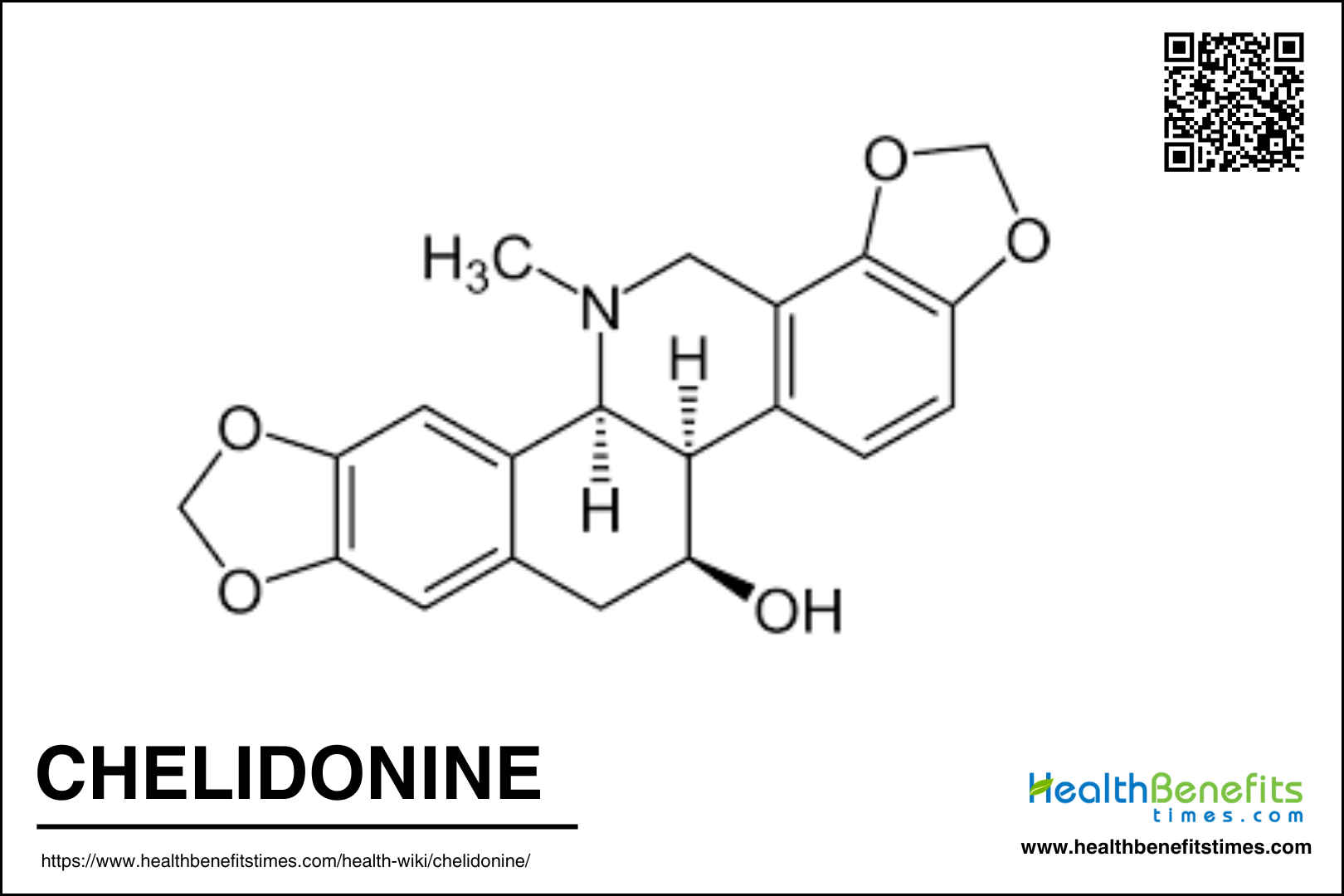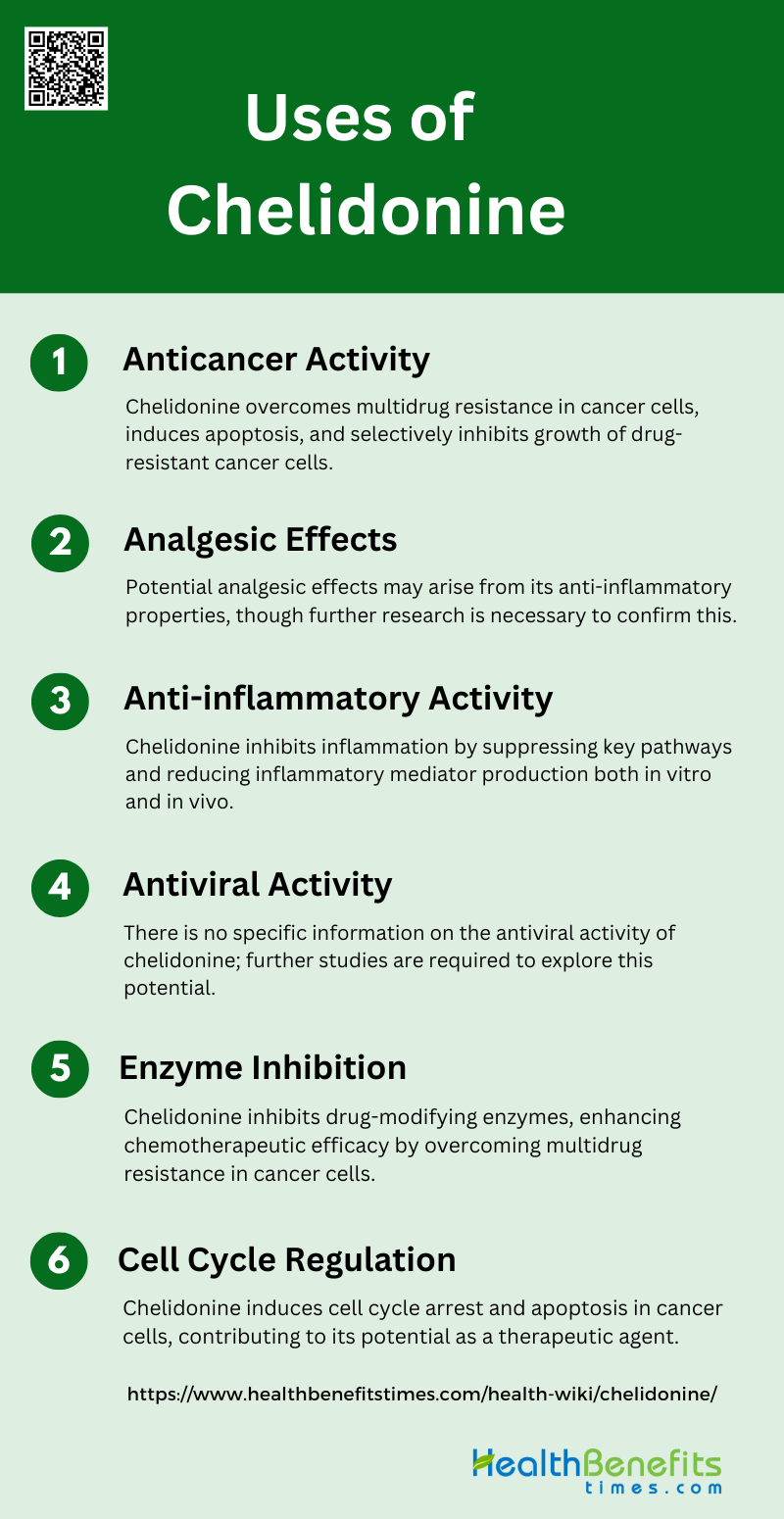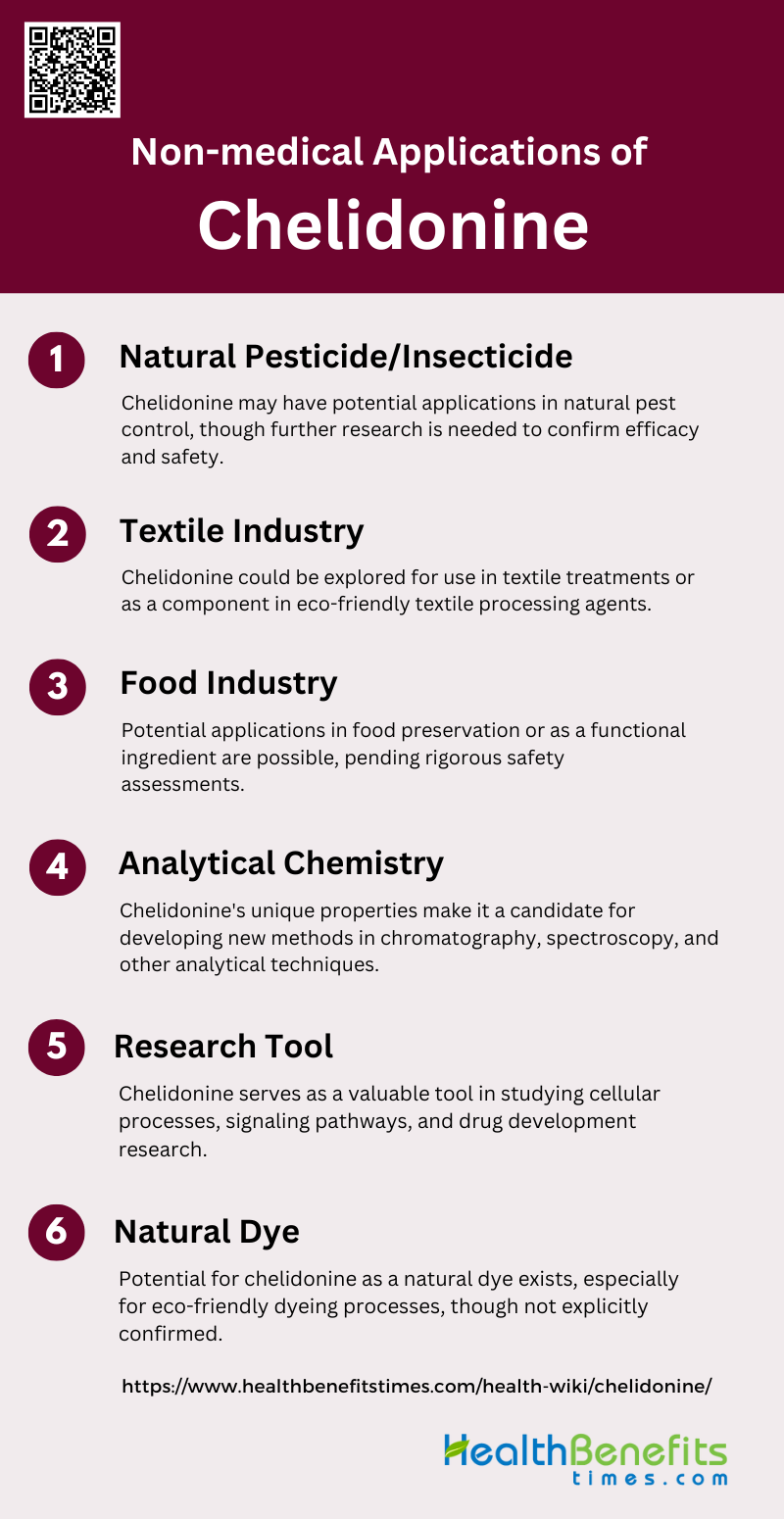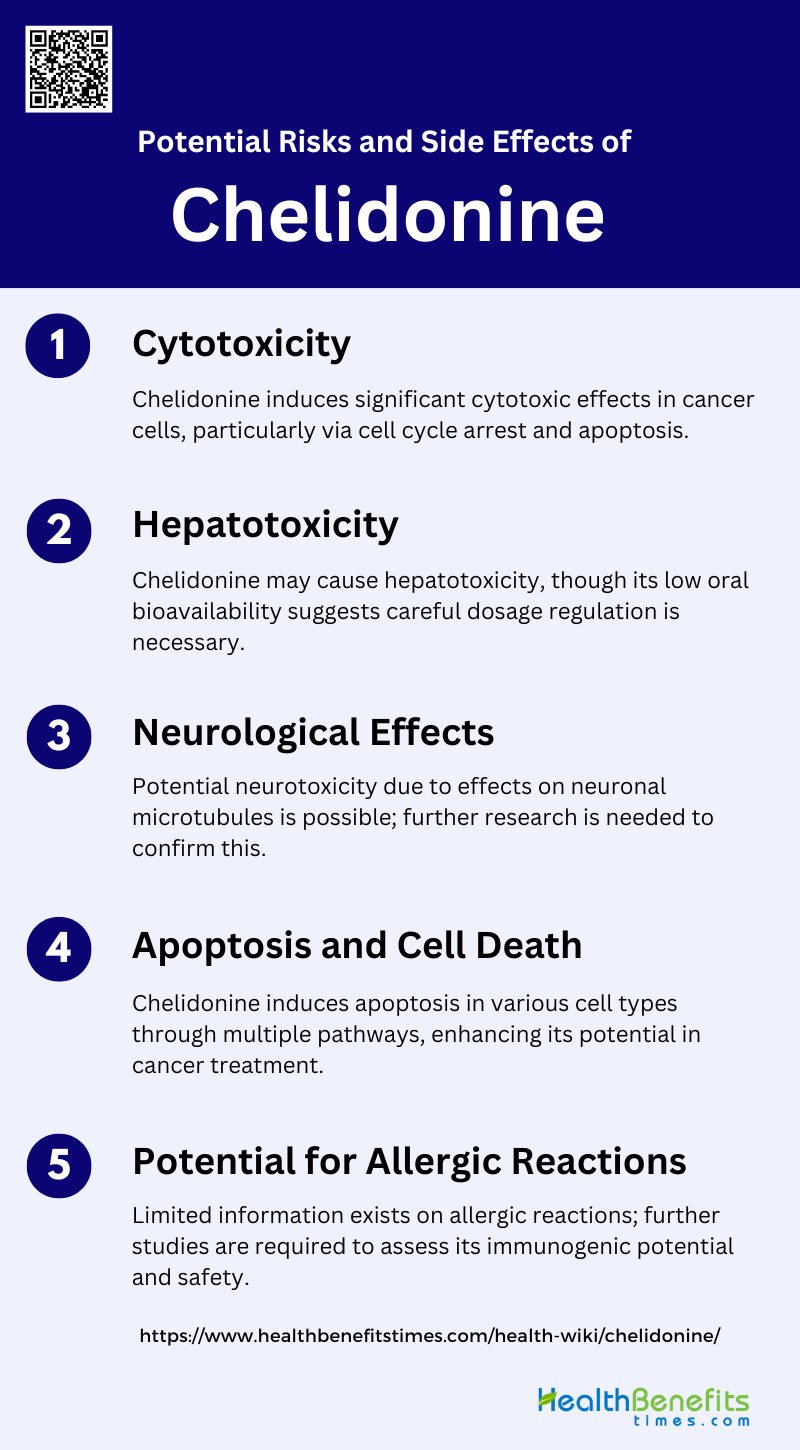Chelidonine is an alkaloid primarily found in the plant Chelidonium majus, commonly known as greater celandine. This compound is noted for its cytotoxic properties, particularly its ability to inhibit the proliferation of cancer cells. Research has shown that chelidonine can induce apoptosis and arrest the cell cycle in various phases, such as G1 or G2/M, thus contributing to its antiproliferative effects. It has been studied for its potential anti-cancer properties, particularly in head and neck cancer cell lines, where it has been observed to suppress growth, invasion, and angiogenesis, although its effects are not always dose-dependent. Additionally, chelidonine has demonstrated the ability to inhibit the nuclear localization of β-catenin, an important factor in the Wnt/β-catenin signaling pathway, which is often implicated in cancer stem cell activities. Despite these promising properties, the efficacy and safety of chelidonine as a therapeutic agent require further investigation.
How Chelidonine works in the body
Mechanism of Action
Chelidonine, a benzophenanthridine alkaloid, exerts its effects primarily through interaction with cellular microtubules and various signaling pathways. It inhibits tubulin polymerization, leading to disruption of the microtubular structure and causing G2/M cell cycle arrest characterized by abnormal metaphase morphology and increased cyclin B1 levels. Additionally, chelidonine induces apoptosis in HeLa cells by generating reactive oxygen species (ROS), causing DNA fragmentation, and altering mitochondrial membrane potential. It upregulates pro-apoptotic genes like p53 and downregulates anti-apoptotic genes such as AKT and PI3K, indicating its role in the p38-p53 and PI3K/AKT signaling pathways. Chelidonine also suppresses inflammatory responses by inhibiting the TLR4/NF-κB signaling pathway, reducing the production of inflammatory mediators like TNFα and IL-6.
Comparison with Similar Compounds
Chelidonine shares similarities with other alkaloids from Chelidonium majus, such as homochelidonine, in terms of its cytotoxic effects on cancer cells. Both compounds induce cell cycle arrest and apoptosis, but chelidonine shows more potent effects, particularly in upregulating phospho-Chk2, p21Cip1/Waf1, and phospho-p38, which are crucial for cell cycle regulation and apoptosis. Compared to tyrosine kinase inhibitors (TKIs) like gefitinib, chelidonine effectively inhibits the growth of gefitinib-resistant non-small cell lung cancer cells by targeting the EGFR-AMPK pathway and mitochondrial function. Furthermore, chelidonine and its derivatives exhibit enhanced antiproliferative activity and selectivity against various cancer cell lines, demonstrating lower IC50 values and higher selectivity compared to the parent compound. This highlights chelidonine’s potential as a versatile anticancer agent with mechanisms distinct yet complementary to other known compounds.
Historical and Traditional Uses of Chelidonine
Traditional Medicinal Uses in Various Cultures
Chelidonine, a major alkaloid found in Chelidonium majus (greater celandine), has been traditionally used in various cultures for its medicinal properties. In European folk medicine, it has been extensively applied for treating liver diseases, jaundice, and digestive disorders, inspired by the theory of signatures which suggested that the plant’s yellow latex was beneficial for bile and liver dysfunctions. The plant’s hepatoprotective and choleretic activities have been well-documented, although modern pharmacology has not fully endorsed these uses due to safety concerns. Additionally, Chelidonium majus has been used in Central and Eastern Europe for pain relief and treating ophthalmological problems, showcasing its diverse applications in traditional medicine.
Folk Remedies and Anecdotal Uses
Folk remedies and anecdotal uses of Chelidonine are rich and varied, particularly in Eastern European countries where the plant is known by many vernacular names. The fresh latex of Chelidonium majus has been traditionally applied to the skin for treating warts, eczema, and other dermatological conditions. Anecdotal evidence also suggests its use in treating tinea infections and corns, highlighting its broad spectrum of dermatological applications. Despite the lack of robust clinical evidence, some folk traditions have even attributed anticancer properties to Chelidonine, although these claims remain controversial and insufficiently proven. The plant’s antimicrobial and antiviral activities further contribute to its reputation in folk medicine as a versatile remedy.
Composition and Characteristics of Chelidonine
Chelidonine is a bioactive alkaloid derived from the plant Chelidonium majus, known for its diverse pharmacological effects. This compound has garnered attention for its potential therapeutic applications. Below are Composition and Characteristics of Chelidonine:
1. Chemical Properties
Chelidonine is an isoquinoline alkaloid found in Chelidonium majus L., commonly known as greater celandine. It belongs to the benzophenanthridine class of alkaloids and is characterized by its complex molecular structure, which includes a hexahydrobenzo[c]phenanthridine core. Chelidonine is known for its high solubility in supercritical carbon dioxide (scCO2), which facilitates its extraction from plant materials. Additionally, it has been shown to selectively inhibit the growth of certain cancer cells by interacting with the EGFR-AMPK pathway, indicating its potential as a therapeutic agent. The compound is also noted for its inability to form pseudobases, which differentiates it from other benzophenanthridine alkaloids like sanguinarine and chelerythrine.
2. Extraction Methods
Chelidonine can be extracted from Chelidonium majus using various methods, each affecting the yield and purity of the alkaloid. Supercritical fluid extraction (SFE) using scCO2, often combined with co-solvents like ethanol or isopropanol, has been shown to be highly effective in isolating chelidonine with high selectivity and yield. Microwave extraction and traditional methods like tea making also yield significant amounts of chelidonine, although the composition of the extract can vary. Additionally, the use of volatile natural deep eutectic solvents (VNADESs) has been explored as an environmentally friendly alternative, showing higher extraction efficiency for chelidonine compared to traditional acidified methanol methods.
3. Purity and Concentration in Natural Sources
The concentration of chelidonine in Chelidonium majus varies depending on the part of the plant and the extraction method used. Studies have shown that both the aerial and terrestrial parts of the plant contain chelidonine, with supercritical fluid extraction yielding the highest purity and concentration. The use of VNADESs has also been reported to increase the yield of chelidonine by 35% compared to traditional methods. Furthermore, the purity of chelidonine can be enhanced through fractionation during the extraction process, which allows for the separation of enriched chelidonine fractions from other alkaloids. This high level of purity is crucial for its application in pharmacological studies and potential therapeutic uses.
Uses of Chelidonine
Chelidonine has been extensively studied for its diverse pharmacological properties. This compound exhibits a range of therapeutic effects, making it a subject of interest in various fields of medical research. Below are some of the notable uses of chelidonine:
1. Anticancer Activity
Chelidonine has demonstrated significant anticancer properties, particularly in overcoming multidrug resistance (MDR) in cancer cells. It interacts with ABC-transporters, CYP3A4, and GST, inducing apoptosis and cytotoxic effects in various cancer cell lines. Chelidonine inhibits P-gp/MDR1 activity and reverses doxorubicin resistance in Caco-2 and CEM/ADR5000 cells. Additionally, it induces apoptosis through caspase activation and affects the expression of genes related to apoptosis, cell cycle, and drug metabolism. These findings suggest that chelidonine is a promising compound for enhancing the efficacy of chemotherapeutics, especially against leukemia cells. Furthermore, chelidonine selectively inhibits the growth of gefitinib-resistant non-small cell lung cancer cells through the EGFR-AMPK pathway, highlighting its potential in targeting drug-resistant cancers.
2. Analgesic Effects
While the provided data does not directly address the analgesic effects of chelidonine, its anti-inflammatory properties may contribute to pain relief. Inflammation is a common cause of pain, and by suppressing inflammatory mediators, chelidonine could potentially alleviate pain. Further research is needed to specifically investigate the analgesic effects of chelidonine.
3. Anti-inflammatory Activity
Chelidonine exhibits potent anti-inflammatory activity by inhibiting key signaling pathways involved in inflammation. It suppresses LPS-induced production of inflammatory mediators such as NO, PGE2, TNFα, and IL-6 in RAW264.7 macrophages. Chelidonine achieves this by inhibiting the TLR4/NF-κB signaling pathway, reducing the activation and degradation of IκBα, and preventing the translocation of p65 to the nucleus. Additionally, chelidonine decreases serum levels of TNFα, IL-6, and PGE2 in LPS-stimulated mice, demonstrating its anti-inflammatory effects both in vitro and in vivo. It also inhibits TNFα-induced inflammation by suppressing the NF-κB pathways in HCT116 cells, further supporting its potential as an anti-inflammatory agent.
4. Antiviral Activity
The provided data does not include specific information on the antiviral activity of chelidonine. Further research is required to explore its potential antiviral properties.
5. Enzyme Inhibition
Chelidonine has been shown to inhibit the activity of drug-modifying enzymes such as CYP3A4 and GST in a dose-dependent manner. This inhibition is significant in overcoming multidrug resistance in cancer cells, as these enzymes play a role in drug metabolism and resistance mechanisms. By inhibiting these enzymes, chelidonine enhances the cytotoxicity of chemotherapeutic agents and induces apoptosis in multidrug-resistant cancer cells.
6. Cell Cycle Regulation
Chelidonine affects cell cycle regulation by inducing cell cycle arrest and apoptosis in cancer cells. It induces G2/M cell cycle arrest in both MOLT-4 and Jurkat cells, leading to apoptosis characterized by phosphatidylserine exposure, loss of mitochondrial membrane potential, and activation of caspases -3/7, -8, and -9. Chelidonine also activates checkpoint kinases Chk1 and Chk2, further contributing to cell cycle arrest and apoptosis. These effects highlight the potential of chelidonine as a therapeutic agent in targeting cancer cell proliferation and survival.
Non-medical applications of chelidonine
Chelidonine, an alkaloid found in the plant Chelidonium majus, is not only known for its medicinal properties but also for its potential in various non-medical applications. Its unique chemical structure and biological activities make it suitable for diverse industrial and agricultural uses. Below are some notable non-medical applications of chelidonine:
1. Natural pesticide/insecticide
While chelidonine itself is not directly mentioned as a pesticide, it shares similarities with other alkaloids found in plants like neem (Azadirachta indica), which are known for their insecticidal properties. Neem oil, for example, has been studied for its potential as a natural surfactant with insecticidal activity. By extension, chelidonine, being an alkaloid from a plant source, may have similar applications in natural pest control, though further research would be needed to confirm its efficacy and safety in this context.
2. Textile industry
Chelidonine’s potential applications in the textile industry are not directly established, but its properties could be explored in this field. Natural compounds are increasingly being sought for various textile applications, including as surfactants and antimicrobial agents. For instance, neem oil-derived surfactants have shown promise in textile cleaning applications, with added bactericidal properties. Chelidonine, with its bioactive properties, could potentially be investigated for similar uses in textile treatments or as a component in eco-friendly textile processing agents.
3. Food industry
The food industry is constantly seeking natural compounds for various applications, including preservation and functional ingredients. While chelidonine’s specific use in food is not established, natural alkaloids are of interest in this sector. For example, cyclodextrins, which can form inclusion complexes with various compounds, have found applications in the food industry. Chelidonine could potentially be studied for its interaction with such carriers or for its own properties in food preservation or as a functional ingredient, subject to rigorous safety assessments.
4. Analytical chemistry
In analytical chemistry, chelidonine could serve as a model compound for developing new detection and quantification methods for alkaloids or similar bioactive molecules. Its unique structure and properties make it a potential candidate for use in chromatography, spectroscopy, or other analytical techniques. While not directly mentioned in the search results, the development of analytical methods for natural compounds is an ongoing area of research, and chelidonine could contribute to advancements in this field.
5. Research tool
Chelidonine’s biological activities make it a valuable research tool in various scientific disciplines. It could be used as a probe to study cellular processes, signaling pathways, or as a reference compound in the development of new drugs or bioactive substances. In the context of research methodologies, tools like online surveys and netnography have been discussed for qualitative research. Chelidonine could potentially be incorporated into such research designs, particularly in studies related to natural products or pharmacology.
6. Natural dye
The potential of chelidonine as a natural dye has not been explicitly mentioned in the search results. However, many plant-derived compounds, including alkaloids, have been explored for their dyeing properties. Recent advancements in natural dye applications have been noted in the literature. Given chelidonine’s origin from a plant source and its chemical structure, it could potentially be investigated for its dyeing properties, particularly in the context of eco-friendly and sustainable dyeing processes for various materials.
Dosage and Administration of Chelidonine
Recommended Dosages
Chelidonine, an alkaloid derived from Chelidonium majus, has been studied for its therapeutic potential and safety profile. In the European Union, a safe oral daily dose limit of not more than 2.5 mg of Chelidonium alkaloids (CAL) has been established due to concerns about liver toxicity. This dosage recommendation is based on reports of liver symptoms, including acute liver failure, in patients treated with certain C. majus preparations. However, studies have shown that chelidonine and other CALs did not elicit similar adverse effects when administered orally to pigs or rats, suggesting species-specific responses and the importance of adhering to recommended dosages.
Methods of Administration
1. Oral
Chelidonine can be administered orally, which is the most common method for its therapeutic use. Oral administration is convenient and allows for systemic absorption of the active compounds. However, it is crucial to adhere to the recommended dosage limits to avoid potential hepatotoxicity. Studies have indicated that the oral availability of certain CALs is extremely low, which might explain the lower incidence of adverse effects in experimental animals compared to humans. This underscores the importance of careful dosage regulation in oral administration.
2. Topical
Topical administration of chelidonine, particularly in the form of mucoadhesive formulations, has shown promise for localized treatment. For instance, a mucoadhesive vaginal drug delivery system containing Chelidonii herba lyophilized extract and chitosan has been developed for the treatment of vaginitis. This formulation demonstrated high mucoadhesion properties and a prolonged dissolution profile, making it effective for localized treatment with minimal systemic absorption. The low permeability of chelidonine in this formulation further supports its safety for topical use.
Importance of Professional Guidance
Professional guidance is crucial when using chelidonine due to its potential toxicity and the need for precise dosage control. Healthcare professionals can provide personalized recommendations based on individual health conditions and potential drug interactions. The established safe dosage limits and the varying responses observed in different species highlight the importance of professional oversight to prevent adverse effects. Additionally, the development of specialized formulations, such as mucoadhesive systems for topical use, requires professional expertise to ensure efficacy and safety. Therefore, consulting healthcare providers is essential for the safe and effective use of chelidonine.
Potential Risks and Side Effects of Chelidonine
Chelidonine also comes with potential risks and side effects that must be carefully considered. Understanding these adverse effects is crucial for ensuring safe and effective use. Below are some of the potential risks and side effects associated with chelidonine:
1. Cytotoxicity
Chelidonine, an alkaloid derived from Chelidonium majus, has demonstrated significant cytotoxic effects in various cancer cell lines. Studies have shown that chelidonine induces cell death in leukemic T-cells and lung carcinoma cells through mechanisms involving cell cycle arrest and apoptosis. Specifically, chelidonine treatment results in G2/M cell cycle arrest and features of apoptosis such as phosphatidylserine exposure, loss of mitochondrial membrane potential, and activation of caspases. These findings highlight the potential of chelidonine as a cytotoxic agent, particularly in the context of cancer therapy.
2. Hepatotoxicity
Chelidonine and other alkaloids from Chelidonium majus have been associated with hepatotoxic effects. Research indicates that chelidonine can induce cytotoxicity in rat hepatocytes, although it is less toxic compared to other alkaloids like chelerythrine and sanguinarine. The hepatotoxicity is linked to oxidative stress and mitochondrial dysfunction, leading to cell apoptosis. Despite these findings, the actual liver levels of chelidonine in experimental animals were too low to cause significant hepatotoxicity, suggesting that its oral availability is extremely low. This underscores the need for careful dosage regulation in therapeutic applications.
3. Neurological Effects
The neurological effects of chelidonine are not as well-documented as its cytotoxic and hepatotoxic properties. However, given its ability to induce apoptosis and affect cell cycle regulation, there is a potential for chelidonine to impact neuronal cells similarly. The inhibition of tubulin polymerization observed in cancer cells treated with chelidonine could also affect neuronal microtubules, potentially leading to neurotoxicity. Further research is needed to elucidate the specific neurological effects and safety profile of chelidonine in the nervous system.
4. Apoptosis and Cell Death
Chelidonine is a potent inducer of apoptosis and cell death in various cell types. It triggers apoptosis through multiple pathways, including the activation of caspases -3/7, -8, and -9, and the loss of mitochondrial membrane potential. These apoptotic effects are accompanied by cell cycle arrest at the G2/M phase, further contributing to cell death. The activation of checkpoint kinases Chk1 and Chk2 also plays a role in the apoptotic process induced by chelidonine. These mechanisms highlight the potential of chelidonine as an effective agent in inducing programmed cell death in cancer cells.
5. Potential for Allergic Reactions
While the cytotoxic and apoptotic effects of chelidonine are well-documented, there is limited information on its potential to cause allergic reactions. Given that chelidonine is a bioactive compound, there is a possibility of it eliciting immune responses in some individuals. Allergic reactions could manifest as skin rashes, respiratory issues, or other hypersensitivity symptoms. Further studies are required to assess the immunogenic potential of chelidonine and to establish safety guidelines for its use in therapeutic settings.
FAQs
1. What is the source of chelidonine, and how is it extracted?
Chelidonine is an alkaloid primarily extracted from the plant Chelidonium majus, commonly known as greater celandine. Extraction methods include supercritical fluid extraction using scCO2, microwave extraction, and using natural deep eutectic solvents (VNADESs).
2. Is chelidonine available as an over-the-counter supplement?
Currently, chelidonine is not widely available as an over-the-counter supplement due to its potential toxicity and the need for precise dosage control. Always consult with a healthcare professional before using products containing chelidonine.
3. Can chelidonine be used in combination with other cancer treatments?
Research suggests that chelidonine may enhance the efficacy of certain chemotherapeutic agents by overcoming multidrug resistance in cancer cells. However, its use in combination therapy should only be considered under the supervision of a qualified oncologist.
4. Are there any known interactions between chelidonine and other medications?
There is limited information on specific interactions between chelidonine and other medications. However, given its potential effects on enzymes like CYP3A4 and its ability to inhibit various signaling pathways, there could be a risk of interactions with other drugs. Consultation with a healthcare provider is recommended.
5. What precautions should be taken when using chelidonine for skin conditions?
When using chelidonine topically, such as for treating warts or eczema, it is essential to test a small area of skin first to check for any adverse reactions. Prolonged or excessive use should be avoided due to the potential for skin irritation or allergic reactions.
6. How does chelidonine differ from other compounds in greater celandine?
Chelidonine differs from other alkaloids like chelerythrine and sanguinarine found in Chelidonium majus in its cytotoxic potency, ability to selectively inhibit cancer cell growth, and lower toxicity profile. Each compound has distinct mechanisms and therapeutic potentials.
7. What are the signs of potential toxicity from chelidonine use?
Signs of potential toxicity may include symptoms related to liver dysfunction (such as jaundice or abdominal pain), neurological effects (such as dizziness or confusion), or gastrointestinal issues. Immediate medical attention should be sought if such symptoms occur.
8. Are there any environmental or agricultural benefits to growing Chelidonium majus?
While the article mentions potential uses of chelidonine as a natural pesticide, more research is needed to confirm its efficacy and safety in this context. Growing Chelidonium majus could have other ecological benefits, but these are not fully explored.
9. What is the recommended duration of chelidonine use for therapeutic purposes?
There is no standardized recommended duration for using chelidonine due to limited clinical data. Treatment duration should be individualized and monitored by a healthcare provider, especially due to potential risks of toxicity.
10. Can chelidonine be used in pediatric or elderly populations?
The safety and efficacy of chelidonine in pediatric or elderly populations have not been established. Due to potential risks, its use in these populations should be approached with caution and under medical supervision.





